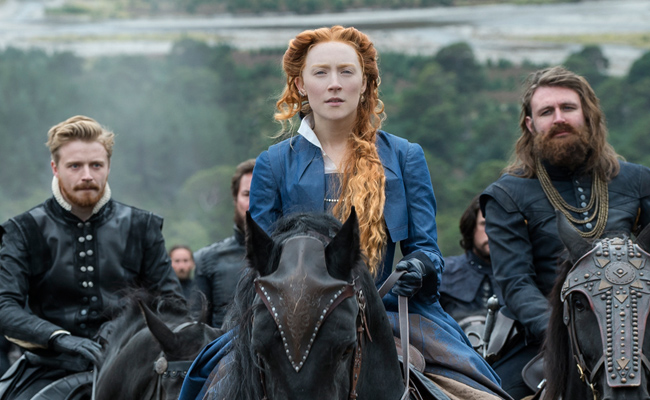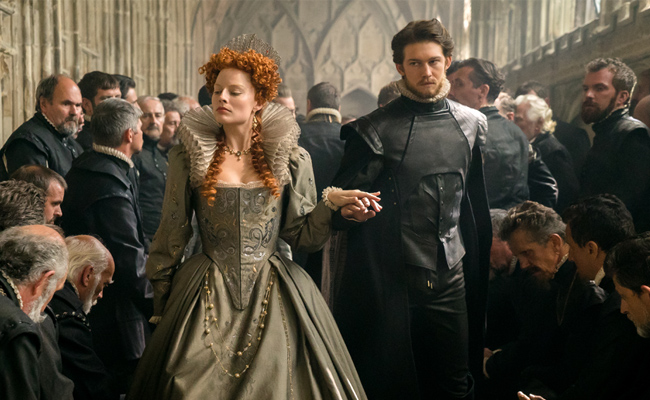
Mary Queen Of Scots has traditionally been depicted as a failed usurper, a footnote in the larger story of Elizabeth I, the long-reigning queen who eventually killed her, and who’s been previously portrayed on screen by everyone from Judi Dench to Cate Blanchett. What Mary Queen of Scots presupposes is, maybe Mary’s story is worth its own movie?
Mary Queen Of Scots, starring Brooklyn‘s Saoirse Ronan in plaits and neck ruffles, is good enough to justify telling Mary Stuart’s story for its own sake, but flawed enough to suggest that maybe this wasn’t the right creative team to do it. The biopic, from theater director Josie Rourke and screenwriter Beau Willimon (creator of the American House of Cards), is consistently compelling but relentlessly inconsistent, a kind of self-destroying drama where characters are completely different from scene to scene.
The film follows its titular character from her arrival in Scotland, widowed by the French king, to assume the Scottish throne from her Protestant half-brother, the Earl of Bothwell (Martin Compston), until the day Elizabeth (played here by Margot Robbie), had her beheaded (400-year spoiler alert). Mary occupies a precarious position both as a Catholic on a Protestant island, a potential rival to the English throne, and a potential sire to a future king, in contrast to her unmarried, childless cousin Elizabeth.
The film takes a schizophrenic approach to both queens, wanting to depict them simultaneously as strong and calculating, and constantly at the mercy of plotters and palace coups committed in their name. Certainly a natural paradox of the age, one could argue, but every story needs motives, and Mary is a confusing mish-mash. Rather than consistent characters colliding to create conflict, characters in Mary Queen Of Scots are constantly reversing themselves — which creates ephemeral twists, but becomes hopelessly murky. We see what they do but never quite understand who they are.
One player in the drama is Lord Darnley, played by Jack Lowden, who looks exactly like if David Beckham and Simon Pegg had a baby. Darnley is a Catholic Englishman and Mary’s first cousin, the latter part of which is never mentioned in the film, which generally glosses over the fact that real-life European royals of the time were universally inbred and probably pretty unattractive (fine, fine, dramatic license, I’d rather look at Margot Robbie too).
In any case, the offspring of a Darnley/Mary union would have a strong claim to the English throne, and presumably be a Catholic, which makes their potential pairing a threat to English Protestantism generally and Elizabeth I specifically. Lowden initially plays Darnley like a smug prep school brat (delightfully so) who woos the undersexed Mary with spirited cunnilingus (was that really a pre-marital loophole back then? probably not but I’ll go with it). They marry (for love or for politics? unclear, like most plot points in the movie) and suddenly it’s heavily implied that Darnley is a homosexual. One who can’t perform sexually without being browbeaten into it (pretty sure none of this was in the Cambridge version).
So which is it?
It seems as if the story wanted some woke points for including a queer storyline, but it’s largely self-defeating. Mary’s secretary, Rizzio, played by Ismael Cordova, is depicted as her gay friend, whose lifestyle Mary knowingly accepts. It could’ve been, and was probably intended, as a necessary corrective to the way, say, Braveheart† (which is otherwise great) depicted its gay character — as a sniveling weakling, whose lover’s fatal defenestration is depicted as a comedic moment. We’ve made some progress since then in that now we’re meant to empathize with Mary Queen Of Scots‘ openly gay character (Rizzio), but the maybe-gay Darnley is… well, still basically the same preening evil coward as Edward II was. Oops, negative woke points.
(†Braveheart is somewhat relevant here, as that film culminated with Scotland’s true independence from England, while this one culminates with the unification of Scotland, England, and Ireland under a single crown.)
Meanwhile, Elizabeth and Mary, the film’s central conflict, have a naturally compelling dynamic. They’re perfect frenemies — two queens on one island, perhaps the only people who could understand each other, yet also rivals, and each in some way possessing what the other lacks and thus covets. Elizabeth eschews marriage and family to sharpen her power; Mary marries, multiple times, but seems only to suffer for it politically, and be accused of all manner of loose blasphemies (conveyed, in this case, by a fulminating pastor, played hammily by David Tennant in a wig and beard stolen from the bridge keeper in Monty Python and the Holy Grail).

Yet with all this to work with, Mary Queen of Scots chooses to focus instead mainly on the mirror mirror on the wall dynamic. Of all the possible takes, was Elizabeth being jealous of Mary’s youth and beauty really the most compelling one? This culminates in their eventual meeting, in an oh-so-symbolic hall of many veils. Elizabeth lays her cards on the table in an act of reconciliation and Mary reacts… confusingly, and self-defeatingly. Even after spending close to two hours with Mary it’s hard to tell what makes her tick. The film can’t quite knit her into a coherent whole.
Bookended as it is by Mary’s execution, the filmmakers seem to understand intuitively that one of the most pressing questions in this narrative is why Elizabeth eventually had Mary killed. The traditional take is that Elizabeth kept Mary on house arrest (on an extravagant estate) against the advice of many who wanted Mary dead, but after Mary tried to instigate one too many coup plots against Elizabeth, Elizabeth eventually, reluctantly, ordered Mary’s execution. Mary Queen of Scots hints that maybe Mary wasn’t actually behind these plots. Which seems at least plausible, history being written by the winners and all. But mostly the film just yadda yaddas the whole thing, glossing over it in some epilogue text as if the answer isn’t even important. Again, which is it?
Mary Queen of Scot’s characterizations are confused, its themes murky. Such that when we leave the theater our dominant impression is “boy, that sure was a story, huh?” Which is to say, a tale in which a lot of wild things happened but we’re not entirely sure what they meant.
‘Mary Queen of Scots’ opens December 7 in New York and Los Angeles. Vince Mancini is on Twitter. You can find his archive of reviews here.






